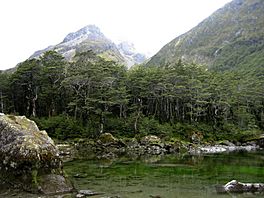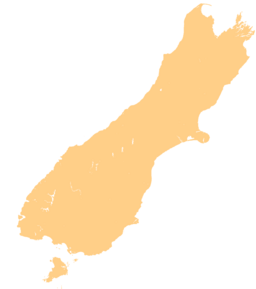Blue Lake (Tasman) facts for kids
Quick facts for kids Rotomairewhenua |
|
|---|---|
| Blue Lake | |
 |
|
| Location | Tasman Region, South Island |
| Coordinates | 42°3′30.6″S 172°39′25.6″E / 42.058500°S 172.657111°E |
| Primary inflows | springs |
| Primary outflows | West Branch of the Sabine River |
| Basin countries | New Zealand |
| Average depth | 7 m (23 ft) |
| Max. depth | 8.5 m (28 ft) |
| Water volume | 180,000 m3 (6,400,000 cu ft) |
| Residence time | <24 hours |
| Surface elevation | 1,180 m (3,870 ft) |
Rotomairewhenua / Blue Lake is a small, special lake found in Nelson Lakes National Park in New Zealand. It's located in the northern part of the Southern Alps. This lake is very important to the local Māori because it holds the clearest natural fresh water in the entire world!
Contents
Discover Rotomairewhenua / Blue Lake
Blue Lake is part of the Buller River system. Water flows out of the lake into the west branch of the Sabine River. The lake gets its water from a short section of the Sabine River above it. This river gets its water from underground. The water seeps through rocks and soil from a bigger lake called Lake Constance. This natural filtering process is what makes Blue Lake so incredibly clear.
The lake has a shape like a boomerang. It stretches about 200 metres (700 ft) in two directions. The water in Blue Lake is quite cold, usually between 5 to 8 °C (41 to 46 °F).
Why Is Blue Lake So Clear?
Blue Lake has the clearest natural fresh water ever recorded! A study in 2011 showed that you can see between 70 to 80 metres (230 to 260 ft) deep into its water. This is even clearer than the 63 metres (207 ft) visibility of Te Waikoropupu Springs, which used to hold the record. To give you an idea, even distilled water (which is super pure) only has a visibility of about 80 metres (260 ft) in a lab.
Scientists believe the water becomes so clear because it travels underground from Lake Constance. This journey acts like a giant filter, removing almost all the tiny bits of dirt and particles from the water. Because the water is so clear, you can see its natural blue-violet color.
Visiting Blue Lake: Access and Facilities
Most people reach Blue Lake as a side trip when they are hiking the Travers-Sabine Circuit. There are also other marked paths that go past the lake, like routes over the Waiau Pass to the south and via Moss Pass to the west.
If you want to stay overnight, there's a place called Blue Lake Hut nearby. It has 16 bunks and provides a place to sleep for over 700 trampers (hikers) every year.
Māori History and Significance
Blue Lake is located in the traditional land, or rohe, of the Ngāti Apa ki te Rā Tō iwi (tribe). In 2010, as part of a special agreement, the lake was given to the tribe and then given back to the New Zealand government.
The Māori people traditionally used the lake for important ceremonies. These ceremonies involved cleansing the bones of the dead to help their spirits begin their journey to Hawaiki, a spiritual homeland. Because of this, the iwi consider the lake's waters to be tapu, which means sacred or forbidden for ordinary use. (Interestingly, Blue Lake was used for males, while Lake Constance was used for females in these ceremonies.)
The Māori name for the lake is Rotomairewhenua. This beautiful name means "the lake of peaceful lands." In August 2014, the lake's official name was changed to Rotomairewhenua / Blue Lake to recognize its Māori heritage.
Images for kids



